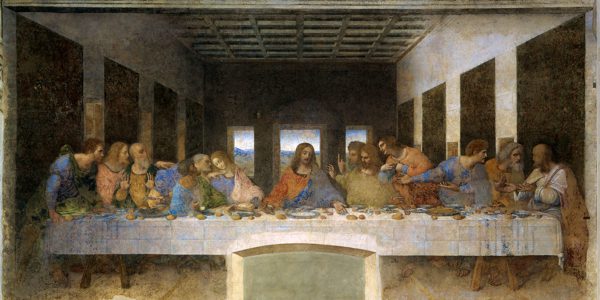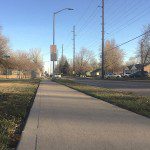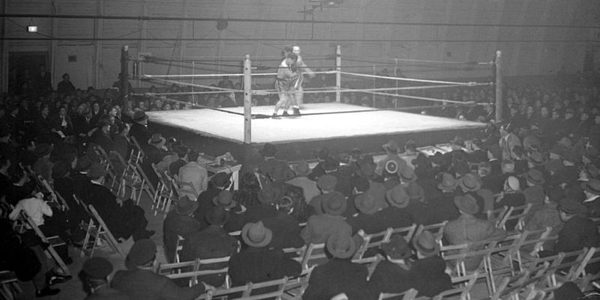This is my sermon from last week. If you are a pastor, feel free to copy and steal everything.
2014.04.06 – John 11:1-45
Lent 05 – Jesus Raises Lazarus from the dead
Eugene Peterson tells a great story about when he was a kid growing up in tiny little town in Montana. It was late August & school hadn’t started yet. Peterson & his friends were bored. Remember that point in the summer when you’d done all the stuff you were excited to do & nothing sounded fun anymore? There was this house on his street that was vacant. Somebody had bought it, & he & his buddies had been waiting all summer for the new people to show up.
Finally one day, a moving van rolled up in front of the house which was an anomaly. In their town when somebody moved, they telephoned every person in town w/ a pickup truck & asked them to help. Peterson’s dad had a truck so he usually got a call. So, Eugene always got to help – which suited him fine; not because he was nice, he says, but because he was nosy. He sorta liked going through people’s houses, carrying things out of basements & attics, getting a look at the behind the scenes lives of his neighbors… that had appeal.
But this was different: it was the first time he had ever even seen a moving van (one of those red, white, & blue American Van line trucks). The movers unloaded all their stuff (family wasn’t even there). Nobody was asked to help, so Peterson & his friends sat there all day watching them unload the new neighbor’s stuff. And everything that came off the truck they viewed as a sign.
Two bicycles came off … probably had children (which meant new friends). Then snow skis: they lived in ski country, but none of them had ever gone skiing – they were too poor (maybe these folks had money). A motorcycle – he’d never been close to motorcycle before. Maybe he could get a ride. When the furniture started coming off it was all nice. All they could think was, “Our new best friends are rich!”
They were just sure they would never be bored again. No more ordinariness. The neighborhood was getting an upgrade. Two days later the new neighbors arrived in a fancy car with New York license plates: Mr. & Mrs. Tipton & 2 teenagers Billy & Cynthia. Not only were their new best friends rich, they were from the exotic east. Peterson writes, “That was the icing on the cake: We could feel the culture and celebrity of the fabled East rubbing off on us. Our neighborhood was suddenly better & more interesting and more important. We couldn’t wait for what was coming next.”
Of course, after all the waiting, & the careful viewing of all the signs, the dream more or less fell apart when they got to know the Tiptons. The kids were stuck up…actually kind of mean. They called Peterson & his friends hicks & hayseeds. He never got to try out the snow skis. He never even got near the motorcycle. Mr. Tipton never spoke a word to him. When the boys were sent to deliver a plate of cookies from Eugene’s mom, Mrs. Tipton thanked them w/out smiling, & shut door. He was hoping for at least a glimpse inside…
The whole thing was a bust. All the new kids ever did was tell them embellished stories about New York. You’d have thought they spent every afternoon in the sun on Jones beach, or at Yankee Stadium, or riding carriages in Central Park, and every night strolling down Broadway seeing movie stars & celebrities.
Peterson says (and this is the point of the whole story), their problem was that they had misinterpreted every sign. They were bored & wanted a little excitement. So every sign was viewed in a way that fit w/their desires for something more exciting to come to their sleepy little town.
John’s gospel sets its readers up for a similar process of observing & interpreting signs about who JS was & what he was up to. As we read John, we are constantly listening to what is said, watching the movements & action, and especially viewing the signs. The challenge is to interpret the signs without just making them mean what we want them to mean… it’s actually a lot harder that it seems.
In John chapter 02, it tells the story of Jesus turning water into wine, and then it says, “This was his first sign.” In John 04, heals the official’s son & it says, “This was his 2nd sign.” Although he stops numbering after that, John keeps using the word “sign” and if you actually count you end up with 7 signs.
- turning water into wine / Jn 02:
- healing the official’s son / Jn 04:
- heals lame man at the pool / Jn 05:
- Jesus feeds the 5,000 / Jn 06:
- Jesus walks on water & calms the storm / Jn 06:
- He heals the man born blind (last week’s story) / Jn 09:
- Jn 11, he raises Lazarus from the dead, which is the 7th sign.
Now, for the Hebrew mind (we’ve talked about this before), everything that has a meaning has another meaning, too. So in the scriptures a seven is never just a seven. It has another meaning as well. The number seven is always closely associated w/creation – the first seven day event. So it’s a pretty good bet that these seven signs are meant to be read as continuation of the work laid out in Genesis & the creation narrative. Especially when you factor in that John’s gospel starts, “In the beginning,” same as Genesis.
So when Jesus shows up in the gospel of John, performing seven signs, it’s not a seven part magic show meant to make him famous. John is telling us that this is a deeply symbolic reinterpretation of the creation story in light of this new thing God is doing in & through Jesus.
If you notice the seven signs build in significance. At first Jesus is keeping everybody’s drink full. Soon he’s healing people, feeding people, and commanding nature. By the 7th sign he’s raising people from the dead. Since they build throughout the seven, it seems that understanding this seventh sign could be a key to understanding all of the signs… even the gospel itself.
If you are like me, what usually happens when we read the signs is that we interpret Jesus’s signs as just proof that Jesus is God. Anybody grow up hearing signs/miracles interpreted in that way?
The only problem is, Jesus never let people interpret the signs that way. In fact he explicitly denied that signs were evidence of his authenticity or identity many times. He said, “false Messiahs and false prophets will appear and produce great signs & omens, to lead astray.” (Mt. 24:24). Signs that re meant to draw a crowd were not to be trusted. Jesus was constantly performing miracles and signs, but refused to do so as validation or proof of his divine authority… and he had harsh words for those who wanted him to: “An evil & adulterous generation asks for a sign.” (Mt. 12:39)
Jesus didn’t seem to think we should be impressed by signs, we shouldn’t go looking for them, attempt to conjure them, or demand them of our leaders. The miraculous is not proof that Jesus is God; they are way more important than that.
It’s not that Jesus didn’t appreciate miracles. In fact, when you read the gospels it’s obvious that Jesus believed God was so present and active in the world… it’d be odd NOT to catch a miracle every now & then. But not as proof that he was God, or validation of his identity… That’s how the false messiahs & hucksters functioned.
Jesus’s miracles & signs are meant to give us a glimpse into the world that God has always imagined for us, a glimpse of who God is & of who we can be, a glimpse of the world as it should be, not as it is. But this can never be turned into a side-show or an authentication. The point is not that Jesus is better than Houdini. The signs are shedding light upon a bigger story, and not just any story. That there are seven signs, and the whole gospel begins “In the beginning,” tells us we are meant to read this as THE big story—creation, fall, redemption, consummation—being retold in a new way, with a radical new orientation.
The Pharisees are not able to interpret the signs correctly, because the signs point to a whole new chapter in God’s story & they simply cannot accept that… they cannot accept the notion that God is doing something new. Jesus seems to know this is a problem. You can’t take these new signs & fit them into the old narrative. You can’t put new wine in old wineskins, they’ll burst; need new wine skins – need a whole new chapter in the overarching story of God. If you are holding to an old story, and you see Jesus’s signs, you’ll likely come up w/a completely different interpretation.
This is what happened in our text from last week. Jesus heals a man born blind – nobody had ever done that… they still haven’t. How do “The Jews” (remember this means the Jewish rulers/Pharisees) interpret that sign? They say Jesus is in league w/the devil, and they kick the man born blind out of the synagogue. Jesus’s sign is interpreted as a threat. Jesus is telling a new story, but the Pharisees & Jewish rulers are a part of an old story.
How you interpret the signs Jesus performs, depends upon what story you think you are living in…
Peterson says, “Signs and wonders, miracles and mighty works are certainly part of the story, yes, an essential part of the biblical story and its continuation and outworking in the Christian life; but out of context, apart from God’s revelation of himself in Jesus, severed and then removed from their organic positionings in the intricate and detailed formation of God’s people, they are simply things, miracle-commodities that are bought and sold on the religious stock exchange.” (Christ Plays in 10,000 Places, P93)
You have to keep the signs in their organic positionings. John situates each of the signs in the midst of a narrative that helps interpret them. That way we can’t make Jesus do what we think he ought to do, or be what we think he ought to be, because there’s particular story… Getting the right story told is the key to understanding the sign. Perhaps this is Jesus’s biggest struggle w/Jewish leaders, and why he gets good and frustrated with them at times. You have to be telling the right story, or you’ll misinterpret the signs.
In our day, some people interpret Jesus’s signs to say that God wants us to be healthy and rich. They insist that the way to become healthy and rich is to give your church a ton of money (…convenient isn’t it? Pastors of local prosperity gospel churches drive Mercedes and Lexus automobiles and live in mansions). They also believe that if you are not healthy and wealth, then something is wrong: you don’t have faith, God is angry, you have unconfessed sin. My conviction is that the reason they do this is because the overarching story they’re a part of isn’t really the Christian story, it’s the story of American affluence. Imagine what happens when you take the prosperity gospel to Africa in the middle of an AIDS epidemic & say disease means don’t have enough faith, or God doesn’t love you, or you have unconfessed sin… all of the sudden the good news isn’t good news. And if the good news isn’t good news in the middle of an AIDS epidemic, then it’s not really good news.
How you interpret the signs Jesus performs, depends upon what story you think you are living in… and Jesus is telling a new story.
After Jesus healed the blind man, he went to Jerusalem for the festival of dedication (Hanukah). He was teaching in the temple & caused huge scene. John’s gospel puts the money changers incident early on in Jesus’s ministry. On this trip to the temple, “The Jews” are at their frustrating nadir. “Tell us plainly, are you the Messiah?” (John 10:24) The gist of Jesus’s answer is “I’ve been doing all these signs; you only see what you want to see. So you cannot see I and the father are one.” (John 10:25-30)
So they try to kill him. Jesus escapes across the Jordan, to the place where John the Baptist was baptizing, which is not an ancillary detail. This is why we read this during Lent. Jesus returns to the wilderness; the place where he was baptized by John, the place where he was tempted. The wilderness, we know, is the place of disorientation that leads to new orientation.
When we pick up the story, Jesus has just learned that his friend Lazarus is very sick. The way John tells the story, he’s making it obvious that it was weird that Jesus didn’t go right away. He doesn’t tell anyone, he doesn’t prepare to leave, or send a message saying, “be there soon.” He just stayed in the wilderness while Lazarus died. Why the two extra days?
Well, the geography tells the story. Where is he? He’s in the wilderness. What is he always doing in the wilderness? Praying & wrestling w/the father’s will. By now Jesus’s conflict with the Jews is heated. They’ve tried to kill him at least twice (Once for the “Before Abraham was I Am” statement in John 8, once for the “I and the Father are one” statement in John 10). Going back to Bethany was a risk.
I had a professor in seminary who when (in talking about controversial issues), he’d say, “You can only go to Jerusalem once.” You better make dang sure this is what God wants. If Jesus goes to Jerusalem he’s going to set events in motion that will end in his death. So he takes a couple of days to pray for direction. While he’s praying God reveals to him Lazarus is dead, and that God is leading him to Jerusalem. He tells his disciples “we’re going.” Thomas says what they are all thinking: “Come along. We might as well die with him.” (if we’re going to die anyway, we might as well die together).
Now, some people think he stayed put for two days so Lazarus would have time to die so he could raise him. That interpretation draws from those who believe the signs are meant merely to authenticate Jesus’s identity. But the way John tells the story, it seems more likely that Jesus has been doing what he always did in the wilderness: listening for God’s voice.
When Jesus finally got there we’re told that Lazarus has been dead for four days. It’s an important detail because there was a common Jewish belief that the soul of a dead person would hang around for three days, hoping to reenter the body. Four days tells the reader that this guy is really dead.
Bethany was near Jerusalem, only a couple of miles away, and we’re told that many of the Jews were visiting Martha and Mary, sympathizing with them over their brother. Which means word was getting around Jerusalem that Jesus of Nazareth was back in the area. The rulers would know.
But Jesus is facing a more pressing problem. His close friend has died, and this is not only a problem for Jesus, it is a problem for God.
Last week we talked about the Jewish concept of Shalom, which means “peace.” But it’s not just inner peace or world peace; shalom means “everything living in proper relationship to everything else; all the world existing in harmony.” Lazarus’s death is a disruption of shalom.
When Jesus faces any kind of disruption of shalom, he moves against it. Here he’s faced with death the ultimate disruption of shalom. So the question is, how is he going to move against death?
Martha comes to meet him first saying (v22), “Master, if only you’d been here, my brother wouldn’t have died. Even now, I know that whatever you ask God he will give you.”
23Jesus said, “Your brother will be raised up.”
24Martha replied, “I know that he will be raised up in the resurrection at the end of time.”
She’s talking about the Jewish belief in the general resurrection of the dead – which is a Christian belief as well: that God will raise all who have died to new life; God will remake our world with its beauty & power enhanced, and its violence and death abolished. Martha believes this is going to happen way in the future, but it’s no consolation right now.
Then Jesus does something incredible which we cannot miss. He asks Martha to imagine that future is suddenly and dramatically brought backwards into the present. The future of God has burst into the present in Christ. The new creation, and with it the resurrection, has broken in to the middle of the old story, transforming it into a whole new story. God is moving against death in and through Jesus. So Jesus says,
25-26″You don’t have to wait for the End. I am the resurrection and the life. The one who believes in me, even though he or she dies, will live. And everyone who lives believing in me does not ultimately die at all. Do you believe this?”
27″Yes, Master. All along I have believed that you are the Messiah, the Son of God who comes into the world.”
Then comes Mary saying the exact same thing:
32″Master, if only you had been here, my brother would not have died.”
33-34When Jesus saw her sobbing and the Jews with her sobbing, a deep anger welled up within him. He said, “Where did you put him?”
34-35″Master, come and see,” they said. Now Jesus wept.
36The Jews said, “Look how deeply he loved him.”
37Others among them said, “Well, if he loved him so much, why didn’t he do something to keep him from dying? After all, he opened the eyes of a blind man.”
Notice Jesus’ reaction this second time. At first, he gets ticked off. I quote the message version here because most translations say “greatly disturbed” or “deeply moved,” or “troubled.” The verbs in the Greek are much more harsh – He’s ticked. It says a “deep anger welled up,” and then it says Jesus wept… he cried.
In the West we have a tendency to sentimentalize the scene. JS is crying because he’s sad is friend died – I think that is a misreading for several reasons. First, we’ve just been told he’s angry. Second, that’s the interpretation offered by “the Jews” in John’s story. “Look how deeply he loved him,” they say. How many times have “The Jews” interpreted JS signs rightly? Never – they always give the wrong answer. Third, this interpretation is part of a sarcastic side conversation, including a crowd impugning Jesus for not healing Lazarus like he did the blind man.
But the biggest giveaway is to notice that he cries in response to an offer to see the tomb. I think that’s key. Whatever else Jesus is feeling at the time, surely he was feeling grief for his own impending death. He knew it was coming – he’d just spent two days in the wilderness discerning if it was time. Death is the enemy, and it had just grabbed hold of his friend Lazarus. Surely he was thinking, “yep, that’ll be me in a few days.” It’s like the intensity of the situation just overwhelmed Jesus, so he cried. It’s a very human moment… shalom had been destroyed & Jesus had to move against it.
The question was: how?
The answer the story gives is this: Jesus decides that he’s effectively trading his life for Lazarus’s life. This is the meaning of the 7th sign: Jesus will die so that Lazarus can live.
You have to remember, as long as Jesus stayed on the other side of the Jordan, he was relatively safe. It was easy to maneuver and he knew the place. The moment he goes over to Bethany, his fate is all but sealed. He’ll be arrested. Even the disciples can see that Jesus is going to trade his life for Lazarus’s life… and so he begins the exchange that will culminate in his trading his life for ours as well.
It seems like an odd thing… Why move against death this way? For all of the certitudes that Christians cling to, surely we have to admit that this is a legit question, and not an easy one at that (if we’re honest). Why did Jesus choose to move against death in this way?
N.T. Wright offers this, both the question & an explanation:
“This passage points us forward to the questions that will be asked at Jesus’ own death. Couldn’t the man who did so many signs have brought it about that he himself didn’t have to die? Couldn’t the one who saved so many have in the end saved himself? John is telling us the answer by a thousand hints and images throughout his book. It is only through his death, it is only through his own sharing of the common fate of humanity, that the world can be saved. There is a line straight on from Jesus’ tears in verse 35 to the death in which Jesus will share, not only the grief, but also the doom of the world.” (John for Everyone).
So, Jesus wept. There was a direct line between the death he was about to overcome w/Lazarus & the death he would die a few days later; a death that would overcome the death of the entire world once & for all. Jesus had come to believe he was bridging God’s future into the present; & he had to trust that when the future of God comes in contact: with the blind, the sick & even the dead… God’s life will overcome death. Jesus had to die the same way we have to die: trusting that God will raise us from the dead. Right now, he knows he is essentially trading his life for his friend.
Think about where we are in the story. They are 6 days before the Passover. Somewhere around a half-million Jews are flooding into the city. Jesus is sitting on the high priest’s doorstep – 2mi away in Bethany. Jesus’s last two trips to Jerusalem have ended in attempts on his life. If he raises Lazarus from the dead, all of Jerusalem will know. There will be no hiding from this…
Possibly the most overlooked reality in the way the Gospel of John tells the story concerns the interpretation of this seventh sign by the Jewish masses. In the span of just a few days Jesus goes from the Jewish people wanting to kill him, to them welcoming him back into Jerusalem like a king. (Palm Sunday story, next week). First they want to kill him. Then they greet him as the King. What happens in between those? The 7th sign…
This miracle is going to sway the crowds. They are going to start to believe he’s the Messiah. And only Jesus seemed to understand that he was trading his life for his friend, and eventually ours. So when he was standing in front of his friend’s tomb, he wept at the pain of it all—the pain, anger and sorrow all mixed together.
And yet, this is the great hope of the gospel: Through the faithfulness of Jesus, God is going to tell a new story (gospel). God has resolved that anything disrupting shalom in this world… its days are numbered. Not just that God will fix it in the end; God is on the move right now. The disruption of shalom is killing things that are meant to live. So God moves against it.
So the real question for us is not, “If you die tonight where you going to spend eternity.” God’s already taken care of that. The question here is what’s killing you right now? What is bringing death into the middle of your life? How long are you going to hold on to your: fear, shame, anger, pain, unforgiveness, addictions, anxiety, or your past? How long until you let God raise you up to new life?
What’s killing you? Let me just tell you the good news: The Spirit of God is alive in this world, the Spirit of Christ is living within you & it’s ready to move against everything that’s disrupting shalom on your life, against everything that’s killing you. God is telling a whole new story… and it’s a story of healing, and redemption, and restoration & the defeat of death & all its friends.
We just have to have a tiny bit of courage & faith… just enough to open up to God, enough to welcome the friend who has come to trade his life for ours. Will you let the spirit of God begin to work in your life, to set you free?
The 7th sign is a sign to all of us that death’s days are numbered. That God will not stand by & let us struggle forever.












